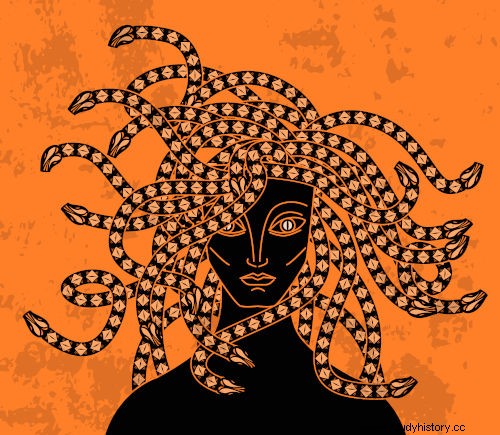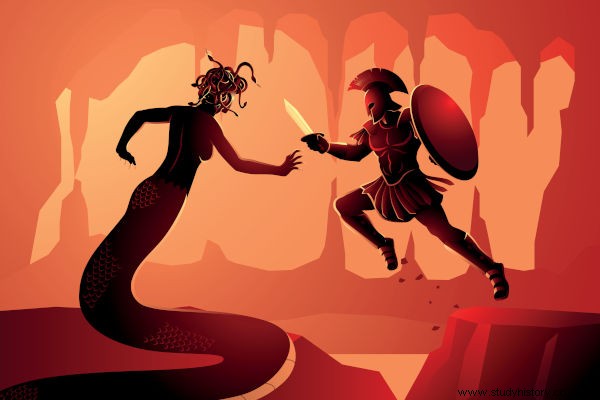
Jellyfish she was a Gorgon, a monstrous being present in Greek mythology. The accounts of Medusa narrate that she had a hideous appearance and that she was able to turn those who looked directly at her to stone. Medusa had two sisters and was the only mortal Gorgon. She was beheaded by the hero Perseus.
Read also :Persephone — the Greek goddess who was kidnapped by Hades and taken to the underworld
Medusa Summary
-
Medusa was a Gorgon, a monstrous being from Greek mythology.
-
she looked hideous and had snakes for hair.
-
she had two sisters, who were also Gorgons. Medusa's sisters were immortal.
-
she was killed by Perseus in her sleep.
-
Her head was used as an adornment for Athena's shield.
Who was Medusa?
Medusa was the name of one of the Gorgons of Greek mythology . The Gorgons were monsters that:
-
looked feminine;
-
possessed the power to turn people who looked directly into their faces to stone.
-
presented snakes on their heads instead of hair, which was their main attribute.
There is some variation in the myths involving the appearance of the Gorgons and Medusa, and their description has become popular as be es monstrong-featured . In general, they were said to have gigantic claws, sharp teeth, and a snake-like body. Gorgons were also described as having wings.
Medusa was the daughter of Phorcys and Cetus and had two sisters named Stheno and Euryale. Medusa's sisters were also Gorgons, and an important fact is that Medusa was the only one of the three Gorgons who was not immortal . She resided in Cistene, but there are Greek authors who claim that she resided in Libya.
The name Medusa comes from the Greek language itself and means “to guard”, “to protect”. As we will see, this is a reference to Athena's shield, which featured Medusa's head as an adornment. That's because in Greek culture Medusa's head was seen as an amulet to ward off evil spirits.
It was quite common for this amulet to be worn by people, but it could also be drawn on the walls of buildings. The most emblematic example is the temple of Artemis in Corcyra. Medusa's head as an amulet was called by the Greeks the gorgonion.
Interesting: A variation of the Medusa legend states that she was a beautiful-looking mortal woman who served as a priestess in the temple of Athena, goddess of wisdom. Medusa would have been punished by Athena for being too vain, which bothered the goddess, but she would also have been punished for desecrating Athena's temple after having had relations with Poseidon, which caused her to have the characteristics for which she is known. .
Login also :Religion of the Vikings — the possessors of a cosmogony of their own
Death of Medusa
The death of Medusa is the best-known chapter of this character in Greek mythology . This myth begins with Danae, daughter of Acrisius, king of Argos. She was imprisoned by her own father because he received the prophecy that her son would kill him.
Zeus entered the chamber that imprisoned Danae and impregnated her with Perseus. So Acrisius decided to put Danae and Perseus in a chest, throwing them into the ocean. The chest arrived on the island of Serifos and was found by Dictys. This man decided to raise Perseus as his own son, and Greek legends tell that Perseus became a great man.

At one point, Perseus asked Polydect (brother of Dictys and King of Seriphos) to give a wedding gift to a woman named Hippodamia. He was unable to give the required gift, a horse, so Polydect demanded that Perseus get Medusa's head and give it as a gift.
There is also a version that points out that the proposed decapitation of Medusa was carried out in a tournament that took place in Serifos. In any case, Perseus' role in this dangerous mission was part of Polydect's strategy to drive Perseus away from his mother, Danae. That's because Polydect was interested in having a relationship with Danae.
Perseus' quest was a fatal quest since, as mentioned, the Greeks considered the Gorgon an extremely dangerous monster. However,Perseus had the support of the gods , who gave him accessories of great value to achieve his goal:to kill Medusa and take her head with him.
The accessories Perseus received were:
-
Elmo: guaranteed invisibility and was given by Hades.
-
Winged sandals: helped with the movement and was a gift from Hermes.
-
Shield: conferred the ability to reflect and was given by Athena.
-
Sword: would be used to decapitate the Gorgon and was a gift from Zeus.
Perseus did not find it difficult to kill Medusa, for when he arrived at her hiding place, she was sleeping. He utilized the reflective shield he received from Athena and headed for a position where he could kill the Gorgon. Then Perseus decapitated Medusa , and from her blood sprang Pegasus, a winged horse, and Chrysaor, a giant.
This happened because Medusa was pregnant with Poseidon at the time she was killed. After beheading the Gorgon, Perseus returned to Serifos, where he took revenge on Polydect, turning the island's king to stone by making him look at Medusa's head. He then handed over the island's power to Dictys and gave Medusa's head to Athena. This goddess adorned her own shield with the Gorgon's head.
